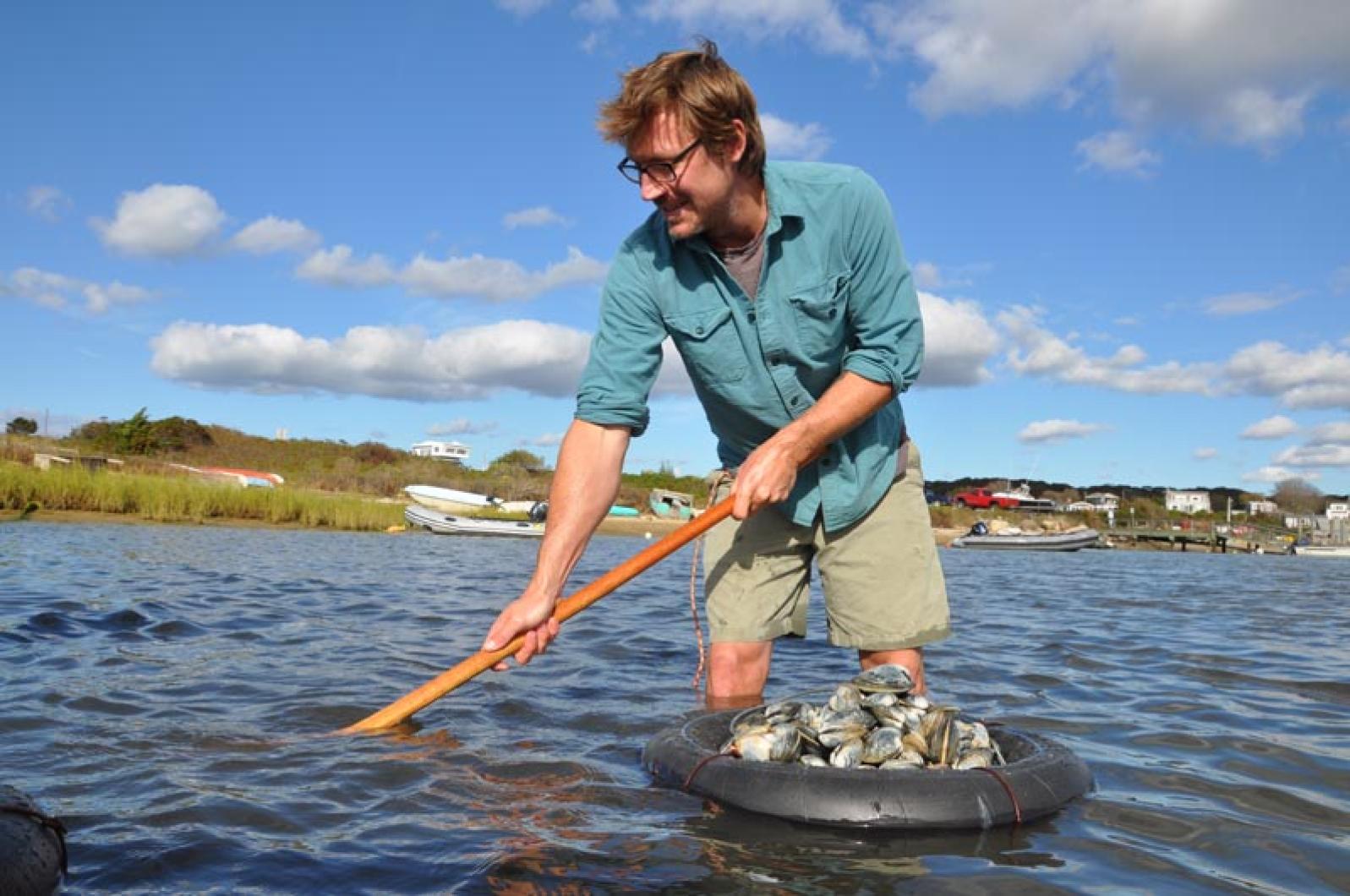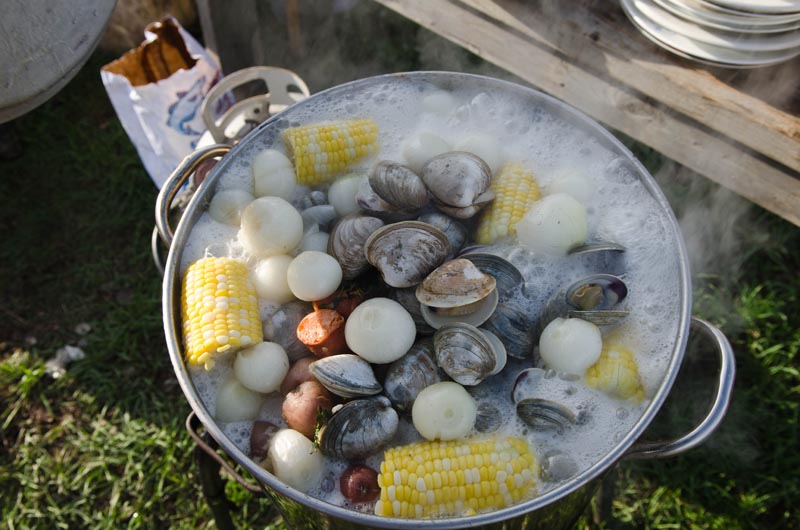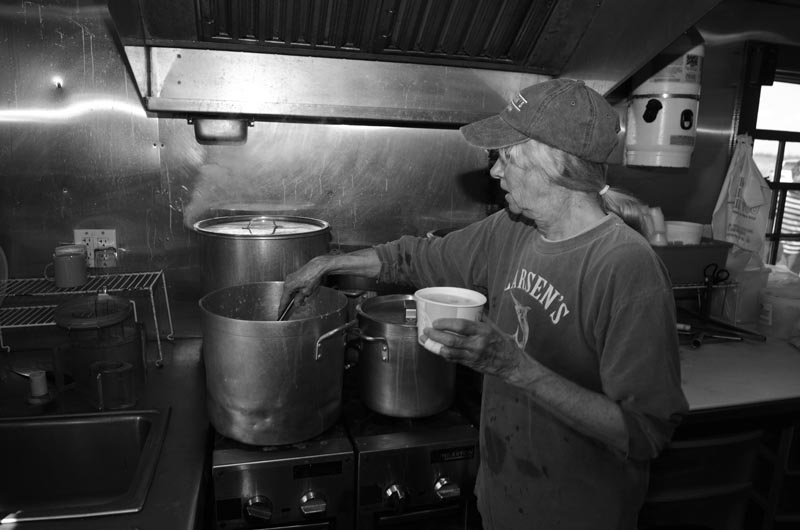My Aunt Marie turned 70 this past August. She is still slender, young in most every way and very strong. To celebrate we roasted a whole pig her son Josh had raised on a spit and had a celebration on the farm. The pig was the centerpiece, with all guests and family members contributing to an epic potluck meal eaten at picnic tables placed where my grandfather’s butterfly weed had bloomed only weeks before. My father documented the whole thing and took a picture of a young, blonde cousin inspecting the head of the hog. Smoke makes its way to the sky in the background and a cleaver used to disconnect the spinal chord from the neck vertebrae is perched next to the head.
My father dug clams and steamed them in a huge pot set over a propane burner with sausages and potatoes. He loves the process of clamming. Putting on your waders, making sure the inner-tube around your clam basket is inflated and most importantly making sure you have a knife on you to open your haul. Last spring he and I dug what must have been a three-pound clam. When our attempts at opening it with a knife failed, he slammed it onto the ground, shattering its shell and proclaimed “Now you can eat it!” I didn’t. But the meat of the clam was so large you could have almost made a chowder from it alone.
My dad makes a mean chowder and loves a special occasion to take three days to prepare his masterpiece. I am always impressed at the quality of ingredients my dad uses for his chowder but they pale compared to what Christine Larsen has to work with at Larsen’s fish market every day of the season they are open. She has the fresh clams and shellfish, as well as an array of broths to choose from coming out of their bustling take-out window. Her chowder is light and rich at the same time, not so thick as to make you regret consumption of it. She uses some dairy to give it body and character, but the starch from the canned potatoes she uses brings everything together for a perfect chowder every time.
She uses fish scraps so fresh it is insulting to call them scraps, to form a base seafood taste in the chowder that is enhanced by the clams and their liquor, added just as the pot is taken off its heat and taken to the walk-in to cool. She has spent her whole life preparing for this task. The daughter of a fisherman and later a fish market owner, Christine grew up eating her mother’s chowder and other delightful cooking. She has gone on to run the same fish market as her father did, with her sister Betsy, who is militant about cleanliness and oftentimes shows up for work in the high season at five a.m. to scrub down the place before anyone else arrives to clean again. The market doesn’t smell fishy, like all other fish markets I have ever been in. It smells like Menemsha Pond in its current tide, because it sits 15 feet away from its water, separated by massive pine docks built and rebuilt many times over the years after hurricanes.
Christine’s secret ingredient in her chowder has nothing to do with quality of seafood. After sweating the onions for about five minutes in butter, she adds an unknown quantity of Japanese sweet wine called mirin to the pot to cook off and reduce before she adds her choice of mussel, clam or lobster broth from the previous day. The mirin adds a sweetness that is embraced by the fish and shellfish as they get to know one another, like coworkers having a drink after work. The alcohol loosens things up, as it always does, and the lobster broth finds out it has much in common with the odd cuts of swordfish. The lobsters that made the broth were from the outer banks and one of their lobster cousins went to boarding school with the daughter of the swordfish that was harpooned to produce those odd cuts. Now they swim together, in different simmering waters, making their individual selves better once they began to collaborate with each other.
Christine Larsen is a poet, a sculptor and a painter all in one when it comes to making chowder. Her well-crafted chowder speaks in so many different mediums, from the sensual warmth deep in the belly to the overwhelming sense of joy taken from a waft of its aroma. She is like Michelangelo plucking granite from perfect quarries in the mountains of Italy to make his masterpieces. She is a master and is surrounded by all she needs to create perfection. But she is much more modern than Michelangelo, who used only one medium at a time, either granite or oil paint; her style celebrates basic vegetables, vibrant stocks and varied raw seafood ingredients put together at the exact moment they will shine their brightest. She is an artist who has honed her craft through years of practice.
When Marie’s daughter Malia was married about 15 years ago, my father volunteered to make chowder for the reception. He spent his usual three days harvesting and preparing all the ingredients, putting together what he hoped would be his masterpiece in his niece’s honor. A northeaster ensued during the wedding and my father walked away from his simmering chowder asking someone to watch it for him. The chowder boiled, then burned and was ruined. To this day family members recall fond memories of that adventurous wedding, while my father dwells on the burned chowder and the one that got away.
Recipe for whole roasted pig
1 whole pig, cleaned, hair removed, weighing between 70 and 100 pounds.
3 heads garlic
As much rosemary as you can find
2 pounds lard
1 box kosher salt
To roast a pig whole, first you have to skewer it on to a spit. Once the pig is in place, rub it down with salt all over its body inside and out. A little heated lard is helpful here because it helps to give the salt something to adhere to on the pig’s skin when rubbed all over the animal.
I build a huge fire about 15 feet from the spit using oak logs and let it burn down, using the embers and coals to spread out around the spit. Spit roasting is always different depending on the situation, but I try not to place any direct flame under the animal so as to avoid flare up from dripping fat. I then spend an entire afternoon rotating the animal every 15 minutes, making sure heat is being distributed evenly throughout the cooking process.
The day is spent shoveling coals from the larger fire to the surrounding pig. Throughout the day baste the skin and the inside of the pig with rosemary and garlic that has been simmering by the animal in lard. The process can go rather quickly or as slowly as you like. I generally start an animal slowly and will cook it as low and slow as I can for as long as I can to render the fat and to make cracklings from the skin.
It should take about six to eight hours to spit roast a whole pig. Once you have deemed it done, remove it from the heat and place whole on a cutting board to rest for 20 minutes and carve. Keep the fire going near by in case the animal is underdone in its shoulders or butt. Serves a lot of people.
Recipe for steamed clams
5 pounds littleneck clams, scrubbed clean
2 pounds pork sausage, poached and cut into 2 inch pieces
2 pounds new potatoes, boiled and salted
1 beer
2 handfuls parsley
In the biggest pot you can find that has a lid, pour the contents of one beer and place over high heat. When the beer has begun to boil vigorously, add the clams, sausage and new potatoes, place the lid on and allow to steam until the clams have opened, which should take about five minutes. When all clams have opened, remove from heat and toss in the parsley, toss vigorously to mix all ingredients and juices and serve immediately, remembering bowls for the empty shells.








Comments
Comment policy »